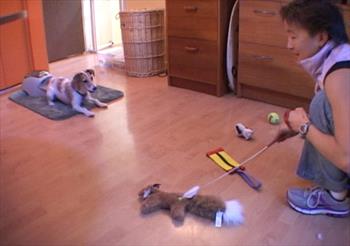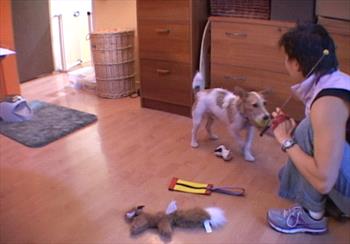I recently saw a great video that laid out the steps for teaching a dog to identify objects that match the item you are holding. That is, if you hold up a squeaky toy in the shape of the mouse and there are 5 different-shaped toys on the floor, the dog should pick up the one that matches the toy you’re holding. This is a dog trick that KayLaurence, a member of the ClickerExpo faculty from England has been teaching to students for several years.
With the steps laid out so clearly, I decided I’d train my dog, Jonesy as well as my dad’s dog, Lucy and compare their speed of learning. My hypothesis was that Lucy, who’s more patient and actually thinks before she performs behaviors, would learn faster than Jonesy. Jonesy has a tendency to just try different things over and over until something works.
This is an account of day 1.
Step 1 in Dog Training Game: Training Jonesy that he must pick up the right toy to get a reward
In this step I started with 3–5 different objects that Jonesy is comfortable picking up. With Jonesy lying down in start position on a rug about 5 feet away, I used a target stick to tap the object I wanted him to pick up and then said, “fetch.” When he ran over and grabbed it, I said “yes” and gave him a treat. I quickly learned that I could not keep my target stick on the object the way the video I had watched did, because Jonesy would grab the target. So I had to just tap the target and hope that got his attention.
At first Jonesy did well. He always grabbed the right toy. Then I’d reward him with a treat. Sometimes I’d use a clicker to mark the correct behavior or a “yes” and sometimes I’d use the MannersMinder. That is, I’d press the remote control and the MannersMinder would emit a tone and dispense a treat which Jonesy would run to and eat.
But after the first several trials he started messing up. I’d tap the object and he’d look but then he’d run to an object he liked better, such as the tennis ball. So I removed the tennis ball and then he did better for two trials, but then he liked the stuffed animal instead. He’d choose the same wrong toy 3–4 times in a row. When he messed up, I just took the toy from him and told him “too bad,” which he knows means try something else. Then I’d send him back to his rug, and we’d repeat the process.
Next I removed a few toys so that there were only two, and then he improved. By the end he was getting the correct toy about 80% of the time. During the next session I switched the toys and we went through the same process again. Sometimes he looked at the toy I tapped and still chose the wrong toy.
What’s up with Jonesy?
Jonesy’s mediocre results helped me shed some light on a mystery I had been thinking about for over a year. Several years ago, I tested Jonesy on a pointing study with the same results. I’d point to the object housing a hidden treat and Jonesy would only go to the right object about half of the time—even if he looked at the object that I had pointed at first.
The results suggest to me that, although my cue with the target got him to look at the correct object, he was not interpreting the cues to mean that he should do something with that object. They also suggest that it might be difficult for dogs like Jonesy to override what’s in their mind already. As he waits on the rug facing a bunch of toys that he will soon have the opportunity to fetch, he may already have formed an idea in his mind of the toy he thinks is the right answer, so he doesn’t really “listen” to me.
Both reasons seem to fit Jonesy. As a young dog he was not very bonded to his humans and took little direction from them. He also was not that interested in praise and petting and was more independent. It’s only through lots of work that he’s learned to focus on and be attentive to me. And overall the personality of many JRTs is to work independently of humans. Also, Jonesy has a history during training sessions of getting stuck on the same answer. For instance if I have him perform tricks he knows well, such as spin and twist and head down, he can consistently perform the right trick. But if I throw in a new trick such as back-up, he’ll suddenly get stuck on just working on that one behavior and has trouble doing the other two.
Soon, I’ll try this with Lucy, my dad’s 1.5 year old Australian Cattle Dog. These dogs have been bred to work with humans and thus to be attentive to them, and Lucy seems to fit that standard. If my hypothesis about Jonesy is right, then Lucy should be quicker at learning to choose the right toy.
Hopefully both he and she can get through this stage quickly so that they can go on to the actual object matching portion of training.




